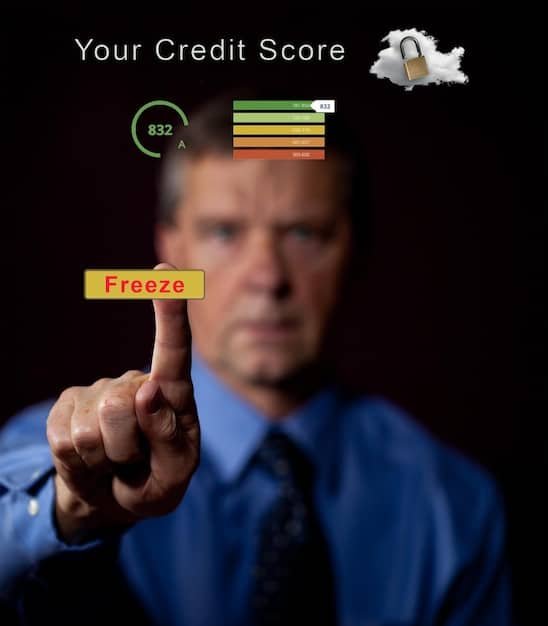The Future of Credit Scores: Exploring Alternative Assessment Methods

The Future of Credit Scores: Alternative Assessment Methods explore innovative approaches beyond traditional credit scores, incorporating data like payment history, cash flow, and alternative financial behaviors to broaden access and provide a more accurate picture of creditworthiness.
The traditional credit score, a three-digit number that has long dictated financial opportunities, is facing a potential revolution. The Future of Credit Scores: Alternative Assessment Methods are emerging, promising a more inclusive and accurate evaluation of creditworthiness. This could reshape how lenders assess risk and how consumers access loans, mortgages, and other financial products.
Understanding Traditional Credit Scores and Their Limitations
Traditional credit scores, primarily FICO and VantageScore, have been the cornerstone of lending decisions for decades. They rely heavily on credit history, including payment history, amounts owed, length of credit history, credit mix, and new credit. However, this system isn’t without its drawbacks.
The Reliance on Credit History
One of the main limitations of traditional credit scores is their dependence on credit history. Individuals with limited or no credit history, often referred to as “credit invisible,” struggle to obtain credit, regardless of their ability to repay. This disproportionately affects young adults, immigrants, and those with low incomes.
Exclusion and Disparities
Traditional credit scoring models can also perpetuate disparities. Factors such as medical debt and student loans can negatively impact scores, even if payments are consistently made. Additionally, inaccuracies in credit reports can lead to inaccurate credit assessments, further hindering access to financial products.

- Limited data: Traditional scoring relies on a narrow set of data, missing out on other indicators of financial responsibility.
- Bias and fairness: Certain demographic groups may be negatively impacted due to systemic biases in the information used.
- Inflexibility: The models may not adapt quickly to changes in financial behavior or macroeconomic conditions.
Ultimately, the reliance on traditional credit scores can create barriers to financial inclusion and opportunity. The need for alternative assessment methods is becoming increasingly clear.
Emerging Alternative Assessment Methods
As the limitations of traditional credit scores become more apparent, a wave of alternative assessment methods is gaining momentum. These innovative approaches aim to paint a more complete picture of an individual’s financial health and creditworthiness.
Payment History Beyond Credit
One of the most promising alternative methods is incorporating payment history for non-credit obligations. This includes rent payments, utility bills, and even subscription services. Consistently paying these bills on time can demonstrate financial responsibility and predict future credit behavior.
Cash Flow Analysis
Analyzing an individual’s cash flow patterns can provide insights into their income stability and spending habits. This data, often obtained from bank account information, can show whether someone has sufficient funds to cover their debts and obligations.

- Broader data sources: Tapping into a wider array of financial data provides a more holistic view.
- Real-time insights: Alternative data sources can often be updated more frequently, offering a more current snapshot of financial health.
- Inclusivity: These methods can extend credit access to those with limited or no credit history, creating a more equitable lending landscape.
These alternative methods have the potential to revolutionize credit scoring, offering a more accurate and inclusive assessment of creditworthiness.
The Role of Technology and Fintech
Technology and fintech companies are playing a pivotal role in the development and implementation of alternative credit assessment methods. Their innovative solutions are making it easier to collect, analyze, and utilize non-traditional data.
AI and Machine Learning
Artificial intelligence (AI) and machine learning (ML) are being used to analyze vast amounts of data and identify patterns that traditional scoring models may miss. These technologies can assess creditworthiness based on a wider range of factors and adapt to changing financial behaviors.
Digital Banking and Open Finance
Digital banking platforms and open finance initiatives are enabling consumers to securely share their financial data with lenders. This allows lenders to access a more comprehensive view of an individual’s financial health and make more informed lending decisions.
- Enhanced data analysis: AI and machine learning provide more effective means of predicting risk using complex datasets.
- Improved access: Fintech platforms can reach underserved communities more efficiently through digital channels.
- Customized solutions: Technology enables personalized credit products tailored to individual financial circumstances.
The integration of technology and finance promises to further refine alternative credit assessment methods and improve access to credit for underserved populations.
Benefits of Alternative Credit Assessment
The adoption of alternative credit assessment methods offers numerous benefits for both consumers and lenders. These methods can lead to greater financial inclusion, more accurate risk assessment, and improved lending outcomes.
Increased Financial Inclusion
Alternative credit data can help expand access to credit for those who are traditionally excluded from the financial system. By considering factors beyond credit history, lenders can identify creditworthy individuals who may have been overlooked by traditional scoring models.
More Accurate Risk Assessment
By tapping into a wider range of data, lenders can gain a more complete and accurate understanding of an individual’s ability to repay. This can lead to more informed lending decisions and lower default rates.
The advantages are clear – alternative methods enable lenders to offer credit to a larger pool of qualified applicants, boosting economic growth and participation.
Challenges and Considerations
While alternative credit assessment methods offer significant potential, it is essential to address the challenges and considerations that may arise during their implementation. Data privacy, regulatory compliance, and model transparency are all critical areas of concern.
Data Privacy and Security
Collecting and using alternative data raises important questions about data privacy and security. Lenders must ensure that they are complying with all applicable laws and regulations and that they are protecting consumers’ personal information.
Regulatory Compliance
The regulatory landscape for alternative credit assessment is still evolving. Lenders must navigate a complex web of regulations and ensure that their models are fair, accurate, and compliant with all applicable laws.
- Data security: Robust measures must be in place to safeguard sensitive financial information.
- Fairness and transparency: Models should be explainable and free from discriminatory bias.
- Consumer protection: Clear guidelines and consumer education are vital to ensure informed decision-making.
Overcoming these challenges is essential to ensure the responsible and sustainable adoption of alternative credit assessment methods.
The Future Landscape of Credit Scoring
Looking ahead, the future of credit scoring is likely to be characterized by a hybrid approach that combines traditional and alternative assessment methods. This approach will leverage the strengths of both systems to provide a more comprehensive and accurate view of creditworthiness.
Integration of Traditional and Alternative Data
The most likely scenario is that traditional credit scores will continue to play a role, but they will be supplemented by alternative data sources. This integration will allow lenders to make more informed decisions and extend credit to a wider range of consumers.
Personalized Credit Products
As credit scoring becomes more sophisticated, lenders will be able to offer more personalized credit products tailored to individual financial circumstances. This could include loans with customized interest rates, repayment terms, and features.
The landscape will shift towards more adaptable, comprehensive, and consumer-friendly credit evaluation processes, driving financial inclusion and economic growth.
| Key Aspect | Brief Description |
|---|---|
| 🌟 Alternative Data | Includes rent, utilities, and other payment histories. |
| 📈 Cash Flow Analysis | Evaluates income stability and spending habits. |
| 🤖 AI & Machine Learning | Enhances data analysis for risk prediction. |
| 🔒 Data Privacy | Ensuring secure and compliant data handling. |
Frequently Asked Questions
▼
▼
▼
▼
▼
Conclusion
As we move forward, the integration of alternative assessment methods into credit scoring promises a more inclusive and accurate financial landscape. By embracing these innovations, lenders can make more informed decisions, and consumers can gain greater access to credit and financial opportunities.





